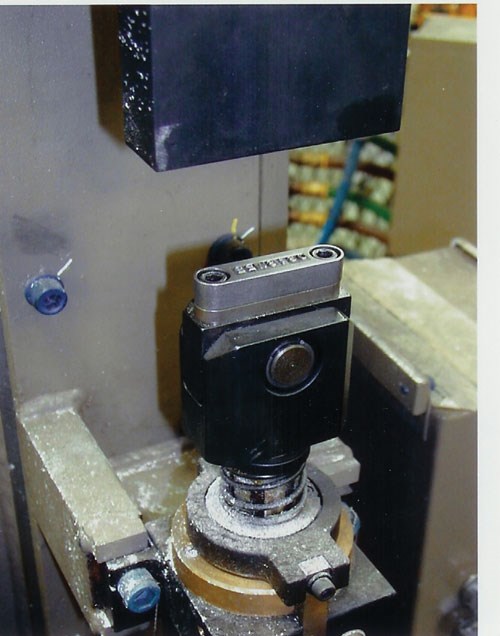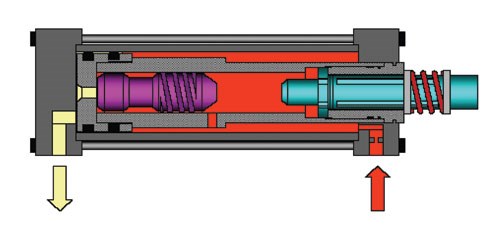Impact Markers Support Green Manufacturing
Impact marking provides an environmentally friendly, cost-effective solution to the issues of traceability and tracking of parts and production processes.
Today’s manufacturers are implementing green initiatives in their manufacturing processes to reduce their carbon footprint and become more environmentally friendly while, at the same time, reducing manufacturing costs. Most companies start their green strategy with easily recognizable programs such as replacing light bulbs, launching recycling policies or choosing energy efficient technology. The key is to get manufacturing engaged with green thinking, which in some cases doesn’t have to involve advanced technology.
For example, marking and traceability are key issues in analyzing and tracking parts and production processes in all industries, and they are essential to QS and ISO certification procedures. All parts require some type of marking. Columbia Marking Tools has been providing a range of marking solutions since 1960, including hand stamps, dot peen and scribe marking, roll marking, laser marking and impact marking. Impact marking provides an environmentally friendly, green and cost-effective solution. Laser and dot peen markers use a lot of electrical energy. Inkjet markers tend to be messy in a production environment and create toxic chemical disposal issues. So today, manufacturing is recognizing and applying the green benefits of impact marking.
Conventional impact markers are air-powered devices that take advantage of mass and velocity to compound the marking force generated by air pressure. Columbia Marking Tools Inc. offers a comprehensive line of air impact markers that instantaneously indent a permanent mark into metal surfaces. They have few mechanical parts and are self-contained for ease of application and use. The basic parts of the units include an air-actuated rod housed within a cylinder that is capable of containing and efficiently venting compressed air; a stamp holder (usually integral with the rod); and a stamp. By encapsulating the internal resonance sound within the iron composite casting, the air impact marking action results in a 44-percent reduction in noise level. Operation is initiated by a simple four-way air valve, and the internal patented air controls complete the automatic cycle. Cycle times for all Columbia impact markers, in both directions, range from 0.5 to 0.8 seconds, fed by air valves that have a constant volume of 8 CV. This short duration of air pressure controls both telescoping to the part and generating the impact force to the stamp end of the rod, embedding the characters directly into the part.
Size selection of an impact marker application is a function of the number of parts to be marked, cycle time, material, the number of characters being marked and the marking force required. Stamp life of an air impact marker is determined by the material mark depth and the material hardness. A typical stamp has a duration of 50,000 to 85,000 parts. Maximum hardness for impact marking is under 32 Rc, which fits 90 percent of all parts marked.
Air impact markers are well suited for automatic applications requiring speed and can operate under adverse conditions, even when immersed in cutting fluids. They also can be used in stand-alone marking operations and are a simple, effective method to mark serial and part identification numbers. Where space is less critical, more sophisticated air impact markers provide soft-impact marking and lower noise levels, making them ideal for production line marking. The simplicity of air impact marking systems results in very low maintenance.
In most new manufacturing systems, the marking requirements are part of the processing discussion between the machine builder and the manufacturer. Engineers from marker manufacturers are usually asked to review the machine tool marker applications and sign off on their use. In the automotive industry, impact markers are finding increased use in robotic welding/assembly cells, where they can be integrated as a marking station in the process. One automotive manufacturing engineer says, “We find impact marking to be the fastest, most durable and least costly method of marking parts. It’s very basic and only takes four bolts and two air lines to get you up and running. The quick-change design of the impact marker simply requires taking off the retainer and the backing plate to change the stamp. We can do that in less than a minute. With a dot peen type marking machine, changing over marking pins takes at least 5 minutes, and with a laser machine, just cleaning the lens takes at least 10 minutes. With an impact marker, there are practically no consumables because we only have to change stamps once a month.”
Costs for impact markers can range from $190 to $2,000, depending on the application. One to eight characters can be marked into most metals, including heat-treated steels. With 20 to 100 psi of operating pressure, marking pressure from 1,500 to 30,000 lbs can be obtained.
Columbia Marking Tools is a designer and manufacturer of metal and plastic marking equipment, including stamps, roll marking dies, roll marking and impact marking machines, fully programmable peen/scribe marking and UID/Square-Dot scribe marking machines, numbering heads and special marking machines.
Related Content
Lone Shop Machinist Benefits From Five-Axis CAM Modules
This California shop owner applies five-axis strategies for more efficient milling of parts with challenging geometries, free-form surfaces and deep cavities.
Read MoreHack-Proof Your Shop: Production Machining’s 6 Must-Read Cybersecurity Articles
October is cybersecurity awareness month and Production Machining wants to help you make your shop hack-proof.
Read MoreWho Are the DFM Consultants? You Are.
Modern shops are bolstering their engineering staff to better offer design for manufacturability advice to their customers. Here, one industry expert suggests ways to develop a common language between manufacturing and engineering.
Read MoreSoftware Controls Chip Breaking in Thread Turning Operations
This cutting tool manufacturer has developed a software module for chip control of thread turning operations in virtually any CNC lathe, even for older machines, using specific tooling and software.
Read MoreRead Next
Turning Small Parts In A Big Way
True to its Southern heritage, Count On Tools (Gainesville, Georgia) makes money the old fashioned way: By earning it. This shop does so by manufacturing complex parts on its multi-axis CNC Swiss smarter and more efficiently than other suppliers to the printed circuit board (PCB) industry.
Read MoreA Tooling Workshop Worth a Visit
Marubeni Citizen-Cincom’s tooling and accessory workshop offers a chance to learn more about ancillary devices that can boost machining efficiency and capability.
Read More5 Aspects of PMTS I Appreciate
The three-day edition of the 2025 Precision Machining Technology Show kicks off at the start of April. I’ll be there, and here are some reasons why.
Read More















.jpg;maxWidth=300;quality=90)










